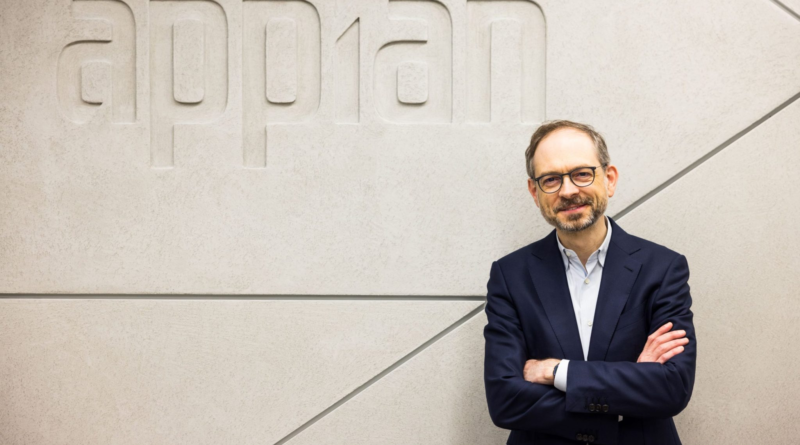Appian’s CEO walked away from millions—twice—but the risk paid off: Now he’s now worth over $4 billion.
Appian’s CEO, Matt Calkins, turned down the chance to be a multimillionaire twice—the first time was when he was just 26 years old.
Calkins was the youngest director at MicroStrategy when he left the company to launch Appian in 1999 with his three friends, Michael Beckley, Robert Kramer, and Marc Wilson. It meant walking away from his shares, which had just ballooned thanks to the company’s IPO one year prior.
“It was my 20s, it seemed like you could walk away from one fortune and just find another,” he recalls to Fortune.
“The reason I left that is because I wanted to have a social impact instead of a financial impact,” the now 51-year-old adds. “Money was not the most important thing to me. I really wanted the opportunity to show what I could do, and I felt like I could have a greater cultural impact, in addition to a financial impact, if I founded my own firm and that was extremely important to me.”
So just like that, Calkins founded a software company called Appian.
Back then, they worked mostly with government agencies: In 2001, the compant developed the U.S. Army’s Intranet—regarded as the world’s largest at the time—before expanding into the corporate world in 2005.
Today, Appian has evolved into a platform that helps leaders with little to no knowledge of app building do exactly that. It currently has over 2,500 clients worldwide, including Aviva, Deloitte, GSK, and KPMG.
Unusually, for a tech company, Calkins and his friends are still running the company 25 years later.
“That is not easy, especially when the stakes are high and people’s greed or envy gets in the way,” he beams. “And the great thing is that 25 years later we still have complete autonomy. I still have control of the business.”
It’s meant Appian has stayed aligned with Calkins’ vision to put values above money—even if it’s sometimes gone against the board’s better (or, maybe in this case, worse) judgment.
He even convinced his co-founders not to sell for millions
It’s perhaps easier to resonate with walking away from millions when you’re full of ambition, young, and have fewer responsibilities—but the founder says as he and the business grew, there were numerous opportunities to cash in. Even outside investors and the board wanted him to sell.
Still, Calkins stuck to his guns. “Because I had the majority of the votes, they couldn’t do it,” he boasts.
“It’s never been about the money,” he says. “The point of this company is to touch as many people’s lives in a positive way as possible… I’ve got enough to live and I don’t need more.”
Calkins put his money where his mouth is for a second time in 2011 when, at nearly 40 years old, he walked out yet again on the chance to sell Appian for $200 million.
With majority steaks in the company, the deal would have made Calkins and his fellow co-founder multimillionaires overnight.
“I had to talk them into it,” he laughs, adding that he took them out for burgers while he made his case.
“They were undecided and actually, I had the votes either way, but they ended up all agreeing with me.”
In the end, placing more importance on his values than what’s in his pocket has actually made Calkins richer.
In 2017, just a few years after turning down the acquisition the board pressed Calkins to go through with, Appian went public on Nasdaq. Its shares soared by over 25% overnight and the company is now valued at around $2.7 billion.
Meanwhile, Calkins’ net worth has been on an upward trajectory since and, in 2021 stood at around $4.1 billion, according to Bloomberg’s estimates.
Looking back to when turned around to his board and said “no” to selling, he says confidence in himself was “the most important thing.”
“I wasn’t saying that the business was necessarily worth more than was being offered for it,” he explains. “I just felt that I could make more of it than was being offered. I felt I had more to do here.”
“Maybe it’s a superpower, ignoring people,” he laughs. “I’ve always felt that I could hear people without following them…. I absolutely didn’t want to do it and so I just didn’t.”
Advice for purpose-driven Gen Z
Many Gen Zers today think like Calkins—and are even willing to walk out of jobs that don’t align with their values. However, they’re also facing record-high living costs, a housing crisis and a tougher than-ever job market.
They needn’t stress, Calkins says. In his eyes, there isn’t a trade-off between making money, being successful and doing purpose-driven work.
“We falsely assume that the good things we do are done for free—like the days we work, maybe we’re not doing anything good, but then when we take a day off and we help at the homeless shelter, then we are doing something good,” he says.
“I think I do more good in a day at the office than I would do if I walk down the road to a charity and spent my entire day there because what I’m doing here, I’m actually good at. I don’t know that I could do another thing as well.”
Essentially, you may need to reframe what you think “doing good” looks like, beyond working for charities or firms that specifically work in the sustainability sector.
If you’re helping customers—even if that’s simply helping them build an app a la Appian—then, Calkins says you’re already working at a “force for good”.
“I think people should realize that commercial enterprises are, in many cases, a force for good themselves—and doing well at those is actually contributing a lot to our society.”


